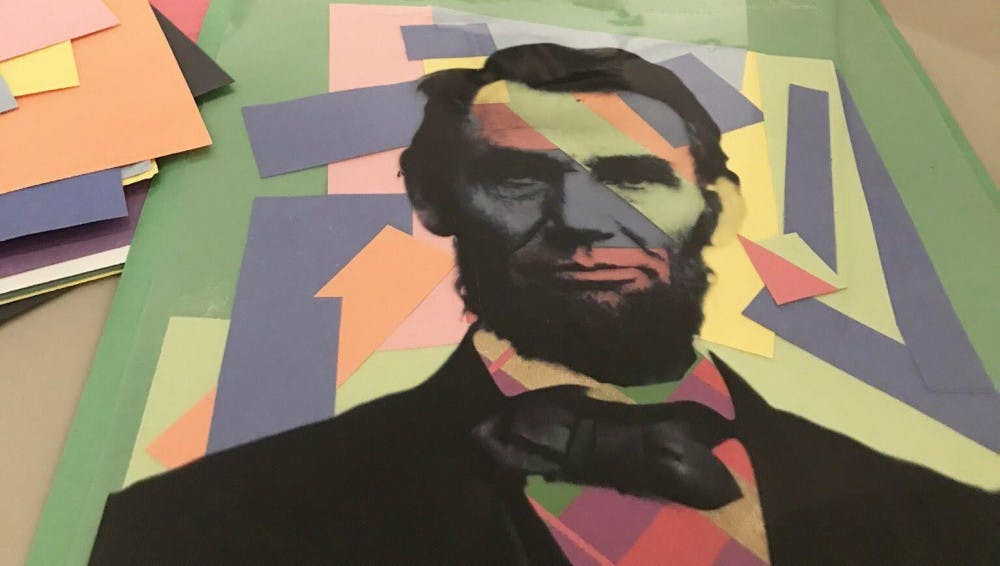Art exhibits are often for strictly observing – but this isn’t to say that they always have to be.
“Sometimes people can express and communicate by a hands-on workshop, and learn from that,” Sara Zela, the communications and education manager for the University of New Hampshire (UNH) Museum of Art, said. “Learn a little bit more about the artist, about the museum, feel comfortable coming here and just have fun and be creative.”
On Wednesday, the Museum of Art hosted a workshop on Icon Portraits as a part of its “Andy Warhol: #NOFILTER” exhibition.
The workshop was designed to give students more hands-on experience with Warhol’s art.
As a long-time Andy Warhol fan, I immediately took up covering the event. Having arrived 10 minutes early, I wandered around the room, studying the collection. Of course, none of the works on display are among the well-known ones, like “Campbell’s Soup Cans.” Rather, the less “mainstream” things, the little pieces from Warhol’s compulsive documentation moments: the Polaroids, the black and white photographs of Warhol’s friends and some silkscreen prints.
Warhol’s silkscreen technique is, perhaps, one of the most well-known art styles of his. Starting in the 1950s, he had photographs transferred onto a mesh of a silkscreen and used an ink-soaked squeegee to apply color to it. This process allowed him to make multiple reproductions of the same photograph in various colors, such as the famous Marilyn Monroe pop-art.
Wednesday’s workshop focused on the same idea, but without following Warhol’s technique precisely. Silkscreen technique requires some training and much more sophisticated materials, but the Museum of Art found an easier way to let students apply their creativity. The museum supplied a series of celebrity photographs, ranging from Abraham Lincoln to the rapper Drake, printed on transparent plastic sheets, a lot of colored paper and the background of Warhol’s process.
“I want [students] to be exposed to the works in the collection,” Zela said. “I want them to take time to look at these portraits… and then express themselves by making their own portrait.”
First, the transparent plastic sheet with the image was hinged on a background of choice by using glue applied only to one side of the sheet. Then, with the snipping of scissors and the rustling of construction paper, the creativity commenced.
I went with Lincoln’s image. At first, I decided to take a minimalistic approach, but as I begun to cut and stick, my inner first-grader broke loose. Soon, my green background with a couple of yellow rectangles stuck onto it was replenished with paper shapes of every color I could get my hands on and some patterned paper, too. Forty minutes later, my background would have probably passed under abstract cubism art style, and, after Lincoln’s face was draped over it, turned out to have very little in common with Warhol’s iconic works.
Maybe construction paper and some glue do not produce the same result as professionally printed photographs and a squeegee, but they do provide an experience of creating something. The workshop was wonderfully organized, joining Warhol’s ideas with accessible supplies that do not require special art training to use and providing the hands-on experience the museum strives for.
“We want people to utilize the museum as a space where they can think creatively, critically and help with their learning at the university,” Zela said.
The “#NOFILTER” exhibition of Andy Warhol’s works (donated to the UNH Museum of Art by the Warhol Foundation as a part of its Andy Warhol Photographic Legacy Program) is running until October 12 alongside “Orly Cogan: Children of Eden.” The museum is located in Paul Creative Arts Center, and is open Monday, Tuesday, Wednesday and Friday from 10 a.m. to 4 p.m., Thursday from 10 a.m. to 6 p.m. and Saturday from 12 p.m. to 4 p.m. Admission is free.














